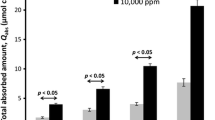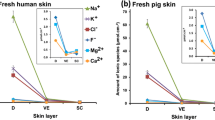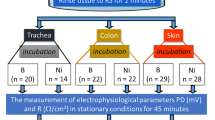Abstract
Fluphenazine (FPZ) and trifluoperazine (TFP) are phenothiazine derivatives commonly used as antipsychotic transquilizers. Their mechanism of action is incompletely understood. Epidermal addition of each drug promoted biphasic short-circuit current (SCC) changes across isolated pelvic skin ofBufo arenarum toads. By means of radiotracers fluxes, SCC was found to be given by the algebraic sum of net sodium and chloride transport. A readily stimulant effect was detected a low concentrations (from 1·10−6 mol/l up to 1·10−4 mol/l for FPZ, from 1·10−5 mol/l up to 3.2·10−4 mol/l for TFP) above which inhibition prevailed. Dermal FPZ also stimulated SCC. A higher concentration and time threshold were required. Epidermal 1·10−5 mol/l FPZ stimulation was partially reversible, with a diminished membrane resistance and enhancement of sodium influx, without alteration of sodium efflux or net chloride transport. It could be prevented by amiloride pretreatment, or diminished by dermal sodium removal. Variation of epidermal bulk pH from 5.8 to 8.7 demonstrated that ionized and nonionized molecules contribute to FPZ's effect. Our results suggest that SCC stimulation elicited by FPZ and TFP may be a consequence of direct or indirect modifications on apical sodium conductance.
Similar content being viewed by others
References
Benos DJ, Simon SA, Mandel LJ, Cala PM (1976) Effect of amiloride and some of its analogues on cation transport in isolated frog skin and thin lipid membranes. J Gen Physiol 68:43–63
Benos DJ, Mandel LJ, Balaban RS (1979) On the mechanism of the amiloride-sodium entry site interaction in anuran skin epithelia. J Gen Physiol 73:307–326
Berman DM (1985) Inhibition of stimulated osmotic water flow by fluphenazine, a calmodulin inhibitor, in the isolated toad skin. Comp Biochem Physiol [C] 81:203–208
Berman DM, Soria MO, Coviello A (1985) Biphasic shortcircuit current response of toad skin to fluphenazine and trifluoperazine. IRCS Med Sci 13:208
Casavola V, Svelto M (1984) Effect of trifluoperazine on sodium active transport in frog skin. IRCS Med Sci 12:740
Castillo GA, Orce G, Coviello A (1978) Effecto de la inhibición del transporte de Cl− sobre la corriente de cortocircuito en la piel del sapo. In: INCA (eds) Abstracts of the VII Congreso Argentino de Biologia. Mendoza. Argentina, pp 79
Curran PF, Gill JR (1962) The effect of calcium on sodium transport by frog skin. J Gen Physiol 45:625–641
Feinstein MB (1964) Reaction of local anaesthetics with phospholipids. A possible chemical basis for anesthesia. J Gen Physiol 48:357–374
Grinstein S, Erlij D (1978) Intracellular calcium and the regulation of sodium transport in the frog skin. Proc R Soc Lond [Biol] 202:353–360
Grosso A, Sousa RC de (1978) Vasopressin-like effects of psychotropic drugs in amphibian epithelia. J Membr Biol 40: 305–321
Guth PS, Spirtes MA (1965) The phenothiazine tranquilizers: biochemical and biophysical actions. In: Pfeiffer CC, Smithies JR (eds) International review in neurobiology, vol 7. Academic Press, New York, pp 231–278
Iglesias GE, Zamzoum HO, Coviello A (1983) Automatic system for short-circuit current. Com Biol 2:61–69
Jain M, Wu NYM, Vray LV (1975) Drug-induced phase change in bilayer as possible mode of action of membrane expanding drugs. Nature 255:494–495
Koefoed-Johnsen V, Ussing HH (1958) The nature of the frog skin potential. Acta Physiol Scand 42:298–308
Kwant WO, Seeman P (1969) The displacement of membrane calcium by a local anaesthetic (Chlorpromazine). Biochim Biophys Acta 193:338–349
Levine SD, Kachadorian WA, levin DN, Schlondorff D (1981) Effects of trifluoperazine on function and structure of toad urinary bladder. J Clin Invest 67:662–672
Li JHY, Lindemann B (1983) Chemical stimulation of Na transport through amiloride-blockable channels of frog skin epithelium. J Membr Biol 75:179–192
Mamelak M, Weissbluth M, Maffly RH (1970) Effect of chlorpromazine on permeability of the toad bladder. Biochem Pharmacol 19:2303–2315
Mandel LJ (1978) Effects of pH, Ca, ADH, and theophylline on the kinetics of Na entry in frog skin. Am J Physiol 235:C35-C48
Roufogalis BD, Minocherhomjee AM, Al-Jobore A (1983) Pharmacological antagonism of calmodulin. J Biochem Cell Biol 61:927–933
Seeman P (1972) The membrane actions of anaesthetics and tranquilizers. Pharmacol Rev 24:583–655
Silver PJ, Stull JT (1983) Effects of the calmodulin antagonist, fluphenazine, on phosphorylation of myosin and phosphorylase in intact smooth muscle. Mol Pharmacol 23:665–670
Skou JC, Zerahn K (1959) Investigations on the effect of some local anaesthetics and other amines on the active transport of sodium through the isolated short-circuited frog skin. Biochim Biophys Acta 35:324–333
Smith PG (1977) The effect of chlorpromazine on cell membrane resistance and capacitance. Eur J Pharmacol 45:251–256
Sorby DL, Plein EM, Benmaman JD (1966) Adsorption of phenothiazine derivatives by solid absorbents. J Pharm Sci 55:785–794
Ussing HH (1949) The active ion transport through the isolated frog skin in the light of tracer studies. Acta Physiol Scand 17:1–37
Ussing HH, Zerahn K (1951) Active transport of sodium as the source of electric current in the short-circuited isolated frog skin. Acta Physiol Scand 23:110–127
Weiss B, Prozialeck WC, Wallace TL (1982) Interaction of drugs with calmodulin. Biochem Pharmacol 31:2217–2226
Zadunaisky JA, Fisch FW de (1964) Active and passive chloride movements across isolated amphibian skin. Am J Physiol 207:1010–1014
Zeiske W, Lindemann B (1974) Chemical stimulation of Na+ current through the outer surface of frog skin epithelium. Biochim Biophys Acta 352:323–326
Author information
Authors and Affiliations
Rights and permissions
About this article
Cite this article
Berman, D.M., Soria, M.O. & Coviello, A. Phenothiazines increase active sodium transport across the isolated toad skin. Pflügers Arch. 407, 327–332 (1986). https://doi.org/10.1007/BF00585310
Received:
Accepted:
Issue Date:
DOI: https://doi.org/10.1007/BF00585310




